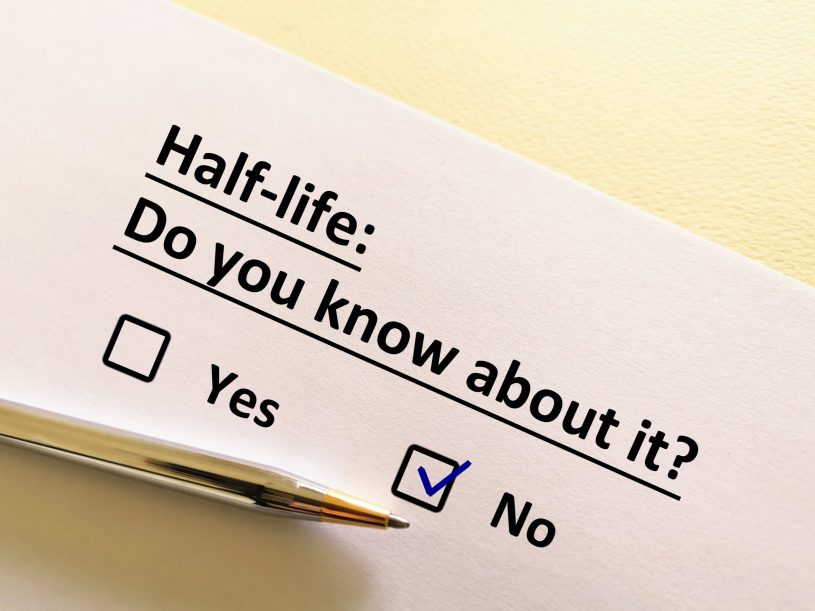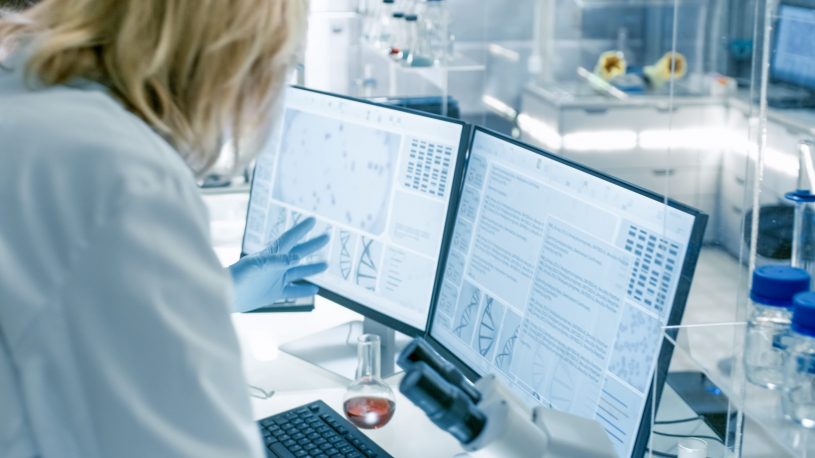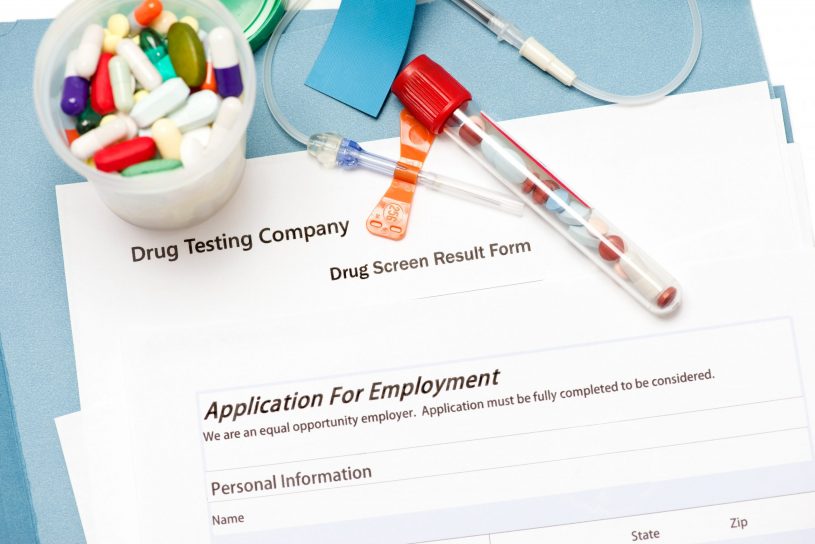Naloxone is a famously fast-acting and widely available medication that is primarily used to quickly reverse the effects of opioid overdose. It is an FDA-approved opioid antagonist that binds to opioid receptors to reverse and/or block the harmful effects of the medication.
Table Of Contents:
With over 47,600 people dying from opioid overdose in 2017 alone, Narcan statistics show that it is an important medicine that needs to be understood in its entirety. Hence, anyone who takes the medication needs to understand the half-life of Narcan, as well as how the body processes it. Here is what those who use the medication should know about how long does Narcan stay in your system.
Naloxone Half-Life
Naloxone hydrochloride is a fast-acting drug that can quickly be removed from the system depending on its type. Naloxone half-life or how long it takes for the concentration of the medicine in the plasma to be reduced by 50%—is in the range of just one to two hours, depending on the method of ingestion.
In some cases, it may be beneficial to look at the alpha naloxone half-life, which is the initial phase of rapid plasma concentration decrease versus the beta naloxone half-life, which is the gradual decrease of plasma concentration that comes directly after the alpha phase. The alpha half-life of Narcan is just four minutes. Meanwhile, the beta half-life of Narcan comes in at about 60 minutes.
Essentially, it is necessary to understand naloxone half-life in order to determine the effectiveness of treatment. However, there are more factors that affect how long Naloxone stays in the system. This will be discussed in the next sections of the article.

Naloxone Mechanism of Action
Naloxone mechanism of action or how it actually works is not fully understood by experts. Hence, knowing exactly how long does Narcan stay in your system is not easily available to the public. It is usually administered only as an emergency treatment for opioid effects reversal. As far as we know, this particular medication is an effective treatment against opiates by acting as an antagonist at several receptors in the CNS including the mu (at highest affinity), kappa, and sigma receptors. The medication works by blocking receptors where opioids usually attach to trigger the release of dopamine. Take note that opioid overdose happens when these medicines cause too much CNS depression which results in slower respiratory function.
However, this specific drug works differently compared to other opiate reversing drugs like nalorphine and levallorphan such that it has little or no agonistic activity. This particular treatment has almost no effect when administered to patients who have not recently taken opiates.
Extremely high doses of this medicine also do not produce significant analgesia and respiratory depression. Most often than not, patients that ingest as much as 10 times the medication only feel slight drowsiness.
But for those who have received large amounts of morphine and similar drugs, the naloxone mechanism of action remains effective in opioid impact reversal. However, due to the shorter duration of Narcan in one’s system, the effects of the opioid may return as the impact of the naloxone mechanism of action wanes.
How Long Does Narcan Stay In Your System?
While the half-life of Narcan is short, the medication remains in the system much longer. How long Narcan stays in the system varies depending on many factors, which include the following:
Age
The older a patient is, the longer the possible effectiveness of Narcan is in one’s system. Although it is a fast-acting drug, one’s metabolism can still affect how it is processed by the body. In this case, a younger patient who has a faster metabolic rate can process the medication a lot faster than older individuals.
Weight
Drug metabolism can also be affected by one’s weight. That’s why overweight people or even those who are obese find that medicines, even opioid antagonists such as Narcan, can stay in their bodies a lot longer than those who are thinner.
Liver Function
One’s liver function may affect how long Narcan stays in the system because it is the organ that primarily synthesizes the medication. However, usually, those who are overdosing opioids may have underlying liver injuries. So the effect will still depend on how bad the damage is to one’s liver.
Method of Ingestion
The method of ingestion can also determine how quickly a medicine clears the body.
As the system metabolizes Narcan, it forms a metabolite called naloxone-3-glucuronide. This metabolite is detectible specifically in the urine.
When Narcan is taken orally or intravenously, up to 40% of the metabolites will be excreted within 6 hours. Within a day, 50% of the medication will be excreted. It will reach 70% after two more days. So the answer to how long does Narcan stay in your system can be directly answered as follows: within a week or less, all Narcan metabolites should already clear the body.
Naloxone Pharmacology
When injected into the body, this opioid-reversing drug takes effect almost instantaneously (within 2 minutes). However, the way Narcan works extends beyond the half-life of naloxone and gets into how the body processes the medication. The pharmacology of Narcan can be examined in terms of five things: absorption, the volume of distribution, protein binding, naloxone metabolism, and route of elimination.
Absorption
Drug absorption rates quantify how long it takes for the medication. This impacts how quickly it can generate the desired effects. Indirectly, it also affects how long the medication stays in the system as well. For Narcan, the absorption rate is from 1-2 mins to about 5 mins depending on the route of administration.
Volume Of Distribution
The volume of distribution is used to determine how much of the drug is needed to generate the desired effects in an individual’s system. Because Narcan acts so quickly, it is rapidly distributed all throughout the body, keeping the volume of distribution very low. For adults, the distribution volume of Narcan is normally reported at about 2 liters per kilogram.
It is important to note that when naloxone is distributed throughout the body, it is very prolific and crosses the blood-brain barrier rapidly. For pregnant patients, it can even cross the placenta. However, it remains unknown in Narcan statistics whether the drug can pass through breastmilk. Still, as a precaution, new mothers taking this medicine are advised not to breastfeed for at least 24 hours after treatment.
Protein Binding
Protein binding describes the degree to which Narcan binds to proteins present in one’s blood system. Narcan binds proteins into plasma, but this event is weak compared to most drugs. Narcan primarily binds to plasma albumin but can attach to others as well. The protein binding range for this specific medication is within 32% to 45%.
Naloxone Metabolism
Naloxone metabolism describes how the body processes opioid-reversing treatment. It undergoes hepatic metabolism, which means it is processed by the liver rather than the kidneys. At the liver, it undergoes glucuronidation to create the metabolite naloxone-3-glucuronide. Once metabolized, the body can eliminate the drug from the system.
Route Of Elimination
Naloxone can be eliminated from one`s system through urine. It takes about 72 hours for about 60-70% of the treatment to be excreted as metabolites from the urinary tract.
There’s a lot going on as Narcan gets absorbed in the body. But regardless of one’s volume of distribution, absorption, and metabolism, it remains as a proven safe and effective way to deal with and manage opioid overdose.

Narcan And Positive Drug Tests
Is Naloxone included in a 12-panel drug test? The short answer is no. For many patients, there is a fear that using naloxone can cause a positive drug test. On a scientific level, this fear makes sense. The metabolites produced when processing naloxone are similar in structure to those that emerge after taking opiates. However, naloxone will not produce a positive result when testing for opioids.
This does not mean that someone who takes naloxone is guaranteed to have a negative test result, though. The time Narcan stays in the system, metabolites included is lesser than opioids are. If a person takes Narcan to counteract the effects of opioids, they may be saved from an overdose, but they will not be saved from a positive drug test.
Despite its fast-acting antagonistic effects, naloxone does not eliminate evidence of opioids or mask them. So do note that someone who has taken opiate medication should expect a positive drug test especially if opioids like morphine, heroin, and oxycodone are taken within minutes prior to the test.

Recovering From Opiate Abuse
Narcan is an important and widely available medicine. But it is a medication that must only be taken by those who have overused and abused opiates. It cannot be used by those with depression or other mood disorders. However, some studies say that a mix of Naloxone and Buprenorphine can help reduce the severity of depression.
Despite its almost miraculous effects, Naloxone is not and will never be a treatment for opioid addiction. It is an emergency medication used to save a life but will not ensure that a person does not abuse opioids once more. Hence, the safest route to free oneself from the adverse effects of opioids is to stop using it altogether.
To safely discontinue using opiates and to learn how to stay clean, users should turn to drug rehabilitation centers. There, the proper substance abuse treatment is provided to prevent relapse, as well as ensure longstanding recovery.
Hope Without Commitment
Find the best treatment options. Call our free and confidential helpline
Most private insurances accepted
Page Sources
- Drug Bank Online. https://go.drugbank.com/drugs/DB01183
- National Institute on Drug Abuse. Naloxone for Opioid Overdose: Life-Saving Science. https://www.drugabuse.gov/publications/naloxone-opioid-overdose-life-saving-science
- Nena Messina. Narcan (Naloxone, Generic Name): Addiction And Abuse. 2021. https://addictionresource.com/drugs/narcan/
- Jericho Hallare; Valerie Gerriets. Half-Life. 2020. https://www.ncbi.nlm.nih.gov/books/NBK554498/
- Rachael Rzasa Lynn; JL Galinkin. Naloxone dosage for opioid reversal: current evidence and clinical implications. 2018. Therapeutic advances in drug safety, 9(1), 63–88. https://doi.org/10.1177/2042098617744161
- National Center for Biotechnology Information (2021). PubChem Compound Summary for CID 5284596, Naloxone. Retrieved August 20, 2021 from https://pubchem.ncbi.nlm.nih.gov/compound/Naloxone
- National Center for Biotechnology Information (2021). PubChem Compound Summary for CID 5284595, Nalorphine. Retrieved August 20, 2021 from https://pubchem.ncbi.nlm.nih.gov/compound/Nalorphine
- National Center for Biotechnology Information (2021). PubChem Annotation Record for NALOXONE, Source: Hazardous Substances Data Bank (HSDB). Retrieved August 20, 2021 from https://pubchem.ncbi.nlm.nih.gov/source/hsdb/3279
- National Center for Biotechnology Information (2021). PubChem Compound Summary for CID 71311610, Naloxone-3-glucuronide. https://pubchem.ncbi.nlm.nih.gov/compound/Naloxone-3-glucuronide
- LiverTox: Clinical and Research Information on Drug-Induced Liver Injury [Internet]. Bethesda (MD): National Institute of Diabetes and Digestive and Kidney Diseases; 2012-. https://www.ncbi.nlm.nih.gov/books/NBK548244/
- Medicines.org.UK. https://www.medicines.org.uk/emc/product/6589/smpc#gref
- AB Storrow, et. al. Does naloxone cause a positive urine opiate screen? Ann Emerg Med. 1994. https://pubmed.ncbi.nlm.nih.gov/7978599/
- Roger Weiss. Finding the Best Alcohol and Drug Treatment Programs. 2021. https://addictionresource.com/drug-rehab/
- Ahmed Zayed. Substance Abuse Treatment: An Overview Of Addiction Treatment Programs. 2021. https://addictionresource.com/treatment/




